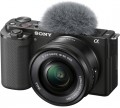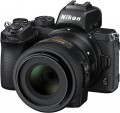Total MP
The total number of individual light sensitive dots (pixels) provided in the camera's sensor. Denoted in megapixels - millions of pixels.
The total number of MPs, as a rule, is greater than the number of megapixels from which the frame is directly built (for more details, see "Effective number of MPs"). This is due to the presence of service areas on the matrix. In general, this parameter is more of a reference than practically significant: a larger total number of MPs with the same size and effective resolution means a slightly smaller size of each pixel, and, accordingly, an increased likelihood of noise (especially at high ISO values).
Effective MP number
The number of pixels (megapixels) of the matrix directly involved in the construction of the image, in fact — the number of points from which the captured image is built. Some manufacturers, in addition to this parameter, also indicate the total number of MPs, taking into account the service areas of the matrix. However, it is the effective number of MPs that is considered the main indicator — it is this that directly affects the maximum resolution of the resulting image (see “Maximum image size”).
A megapixel is 1 million pixels. Numerous megapixels ensures high resolution of the captured photos, but is not a guarantee of high-quality images — much also depends on the size of the sensor, its light sensitivity (see the relevant glossary items), as well as hardware and software image processing tools used in the camera. Note that for small matrices, high resolution can sometimes be more of an evil than a blessing — such sensors are very prone to the appearance of noise in the image.
Maximum image size
The maximum size of photos taken by the camera in normal (non-panoramic) mode. In fact, this paragraph indicates the highest resolution of photography — in pixels vertically and horizontally, for example, 3000x4000. This indicator directly depends on the resolution of the matrix: the number of dots in the image cannot exceed the effective number of megapixels (see above). For example, for the same 3000x4000, the matrix must have an effective resolution of at least 3000*4000 = 12 million dots, that is, 12 MP.
Theoretically, the larger the size of the photo, the more detailed the image, the more small details can be conveyed on it. At the same time, the overall image quality (including the visibility of fine details) depends not only on resolution, but also on a number of other technical and software factors; see "Effective MP number" for more details.
Light sensitivity (ISO)
The sensitivity range of a digital camera matrix. In digital photography, light sensitivity is expressed in the same ISO units as in film photography; however, unlike film, the light sensitivity of the sensor in a digital camera can be changed, which gives you more options for adjusting shooting parameters. High maximum light sensitivity is important if you have to use a lens with a low aperture (see Aperture), as well as when shooting dimly lit scenes and fast-moving objects; in the latter case, high ISO allows you to use low shutter speeds, which minimizes image blur. However, note that with an increase in the value of the applied ISO, the level of noise in the resulting images also increases.
Mount (bayonet)
The type of bayonet mount — mount for interchangeable lenses — provided in a SLR or MILC camera (see "Camera type"). Bayonets come in different sizes, and interchangeable lens specifications usually indicate which mount it is designed for. Most often, mounts of different types are not compatible with each other, but there are exceptions (sometimes directly, sometimes using adapters).
Also note that one brand can use different mounts for different classes of cameras — and vice versa, one mount can be used by several manufacturers. So, Canon releases cameras with mounts
EF-M,
EF-S,
EF and
Canon RF. Leica has
Leica M,
Leica SL,
Leica TL. Nikon has in its arsenal
Nikon 1,
Nikon F,
Nikon Z. Pentax —
Pentax 645,
Pentax K, Pentax Q. Samsung offers
NX and NX-M mounts. Sony cameras have
Sony A and
Sony E, Fuji has
Fujifilm G and
Fujifilm X. And as an example of a mount used by different brands, one can cit
...e Micro 4/3, which is widespread in Olympus and Panasonic cameras.Aperture
Aperture of the lens installed in the camera or supplied with it in the kit (for models with detachable optics).
In a simplified way, this parameter can be described as the ability of the lens to transmit light - in other words, how much the light flux weakens when passing through the optics. It is believed that two main indicators affect the characteristics of light transmission: the size of the relative opening of the lens and its focal length. Aperture is the ratio of the first indicator to the second; in this case, the size of the active hole is taken as one and is generally omitted when recording, as a result, such a recording looks, for example, like this: f / 2.0. Accordingly, the larger the number after the fraction sign, the lower the aperture ratio, the less light the lens transmits.
Zoom lenses (zoom lenses), as a rule, have different aperture values for different focal lengths. For such optics, two values of this parameter are indicated in the characteristics, for the minimum and maximum focal lengths, for example, f / 2.8–4.5. There are also vario lenses that maintain a constant aperture over the entire range of focal lengths, but they are much more expensive than analogs with variable aperture.
The high light transmission of the lens is important if the camera is planned to be used for shooting in low light conditions or for shooting fast moving objects: high-aperture optics allow you to shoot at low sensor sensitivity (which...reduces the likelihood of noise) and at low shutter speeds (at which moving objects are less blurry) . This parameter also determines the depth of field of the imaged space: the higher the aperture ratio, the smaller the depth of field. Therefore, for shooting with artistic background blur (“bokeh”), it is recommended to use fast lenses.
Optical zoom
The magnification factor provided by the camera by using the capabilities of the lens (namely, by changing its focal length). In models with interchangeable lenses (see “Camera type”), indicated for the complete lens, if available.
Note that in this case the magnification is indicated not relative to the image visible to the naked eye, but relative to the image produced by the lens at minimum magnification. For example, if the characteristics indicate an optical zoom of 3x, this means that at the maximum magnification, objects in the frame will be three times larger than at the minimum.
The degree of optical zoom is directly related to the range of focal lengths (see above). You can determine this degree by dividing the maximum focal length of the lens by the minimum, for example 360mm / 36mm=10x magnification.
To date, optical zoom provides the best "close" image quality and is considered to be superior to digital zoom (see below). This is due to the fact that with this format of work, the entire area of \u200b\u200bthe matrix is constantly involved, which allows you to fully use its capabilities. Therefore, even among low-cost models, devices without optical zoom are very rare.
Image stabilization
An image stabilization method provided by a camera. Note that optical and sensor-shift systems are sometimes combined under the term
"true" stabilization, due to their effectiveness. See below for more details.
Stabilization itself (regardless of the operating principle) allows you to compensate for the "shake" effect when the camera is not positioned correctly - especially when shooting handheld. This is especially important when shooting with significant magnification or at long shutter speeds. However, in any case, this function reduces the risk of ruining the frame, so
cameras with stabilization are extremely common. The operating principles can be as follows:
— Electronic. Stabilization is carried out by means of a kind of “reserve” — a section along the edges of the sensor, which is not initially involved in the formation of the final image. However, if the camera electronics detect vibrations, it compensates for them by selecting the necessary fragments of the image from the reserve. Electronic systems are extremely simple, compact, reliable and at the same time inexpensive. However, for their operation, it is necessary to allocate a fairly significant part of the sensor — and reducing the useful area of the sensor increases the noise level and degrades the image quality. And in some models, electronic stabilization is enabled only at lower resolutions and is not available at full
...frame size. Therefore, in its pure form, this option is found mainly in relatively inexpensive cameras with non-replaceable optics.
— Optical. Stabilization is achieved when light passes through the lens — due to a system of moving lenses and gyroscopes. As a result, the image gets to the sensor already stabilized, and the entire area of the sensor can be used for it. Therefore, optical systems, despite their complexity and rather high cost, are considered more preferable for high-quality shooting than electronic ones. Separately, we note that in SLR and MILC cameras (see "Camera type") the presence of this function depends on the installed lens; therefore, for such models, optical stabilization is not indicated in our catalog in principle (even if the kit lens is equipped with a stabilizer).
— With sensor shift. Stabilization performed by shifting the sensor "following" the shifted image. Like the optical one described above, it is considered a fairly advanced option, although in general it is somewhat less effective. On the other hand, sensor shift systems have serious advantages — first of all, such stabilization will work regardless of the characteristics of the lens. For cameras with non-replaceable optics, this means that the lens can do without an optical stabilizer and make the optics simpler, cheaper and more reliable. In SLR and MILC cameras, sensor shift allows even "non-stabilized" lenses to be used with convenience, and when "stabilized" optics are installed, both systems work together, and their efficiency is very high. In addition, sensor shift is somewhat simpler and cheaper than traditional optical stabilizers.
— Optical and electronic. Stabilization that combines both of the above options: initially, it operates on an optical principle, and when the lens's capabilities are not enough, an electronic system is connected. This allows for an increase in overall efficiency in comparison with purely optical or purely electronic stabilizers. On the other hand, the disadvantages of both options in such systems are also combined: the optics are comparatively complex and expensive, and not the entire sensor is used. Therefore, such a combination is rare, mainly in individual advanced digital compacts.
— With sensor shift and electronic. Another type of combined stabilization systems. Like "optical + electronic", it improves the overall efficiency of stabilization, but at the same time combines the disadvantages of both methods (they are also similar: more complicated and more expensive camera plus a decrease in the useful area of the sensor). Therefore, this option is used extremely rarely - in single models of digital ultrazooms and advanced compacts.Number of scene programs
The number of scene programs provided in the camera design.
Scene programs are preset settings for some of the most common shooting scenes - for example, Portrait, Landscape, Sports, Sunset, etc. In addition to these presets, this list may include special effects and creative tools (such as color swap or fisheye), as well as exposure modes (see below). The presence of scene programs is especially useful for beginners and non-professional photographers, as it eliminates the need to tinker with each setting separately - just select the most suitable program, and all the necessary settings will be set automatically. The more scene programs the camera design provides, the wider its automatic adjustment capabilities.

